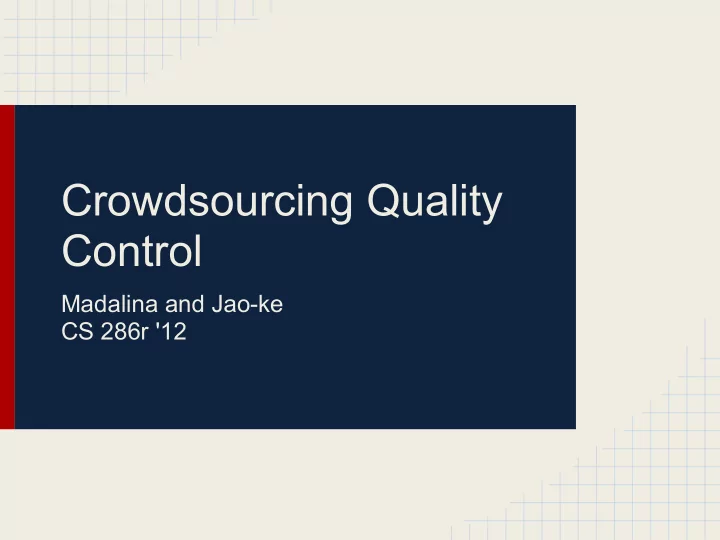

Crowdsourcing Quality Control Madalina and Jao-ke CS 286r '12
Motivation What do we do when we want to answer a question?
Motivation What do we do when we want to answer a question? We ask the questions to lots of people! ●
Motivation What do we do when we want to answer a question? We ask the questions to lots of people! ● What do we want to do when some workers are better than others?
Motivation What do we do when we want to answer a question? We ask the questions to lots of people! ● What do we want to do when some workers are better than others? ● We want to weight the good workers' answers more heavily than those of the bad workers.
Motivation What do we do when we want to answer a question? We ask the questions to lots of people! ● What do we want to do when some workers are better than others? ● We want to weight the good workers' answers more heavily than those of the bad workers. How can we tell which workers are "good" and which workers are "bad"? Proof by majority? ●
Motivation What do we do when we want to answer a question? We ask the questions to lots of people! ● What do we want to do when some workers are better than others? ● We want to weight the good workers' answers more heavily than those of the bad workers. How can we tell which workers are "good" and which workers are "bad"? Proof by majority? ● Nope. (Sorry, democracy.) ●
Set-up Tasks have binary answers ● Each worker performs same number of tasks; each task performed ● by same number of workers Each worker w j has a certain reliability p j ●
Set-up Tasks have binary answers ● Each worker performs same number of tasks; each task performed ● by same number of workers Each worker w j has a certain reliability p j or probability of answering ● a task correctly, for all tasks Example: ○
Set-up Tasks have binary answers ● Each worker performs same number of tasks; each task performed ● by same number of workers Each worker w j has a certain reliability p j or probability of answering ● a task correctly, for all tasks Example: spammer-hammer model ○ Reasonable? How so? How not? ○
Set-up Tasks have binary answers ● Each worker performs same number of tasks; each task performed ● by same number of workers Each worker w j has a certain reliability p j or probability of answering ● a task correctly, for all tasks Example: spammer-hammer model ○ Reasonable? How so? How not? ○ Crowd has average quality ●
Set-up Tasks have binary answers ● Each worker performs same number of tasks; each task performed ● by same number of workers Each worker w j has a certain reliability p j or probability of answering ● a task correctly, for all tasks Example: spammer-hammer model ○ Reasonable? How so? How not? ○ Crowd has average quality q := E[(2 p j -1) 2 ] ●
Set-up Tasks have binary answers ● Each worker performs same number of tasks; each task performed ● by same number of workers Each worker w j has a certain reliability p j or probability of answering ● a task correctly, for all tasks Example: spammer-hammer model ○ Reasonable? How so? How not? ○ Crowd has average quality q := E[(2 p j -1) 2 ] ● Roles of reliability and quality in algorithm? ●
Graph Theory G(V,E) Bipartite Graph: ● ● ● ● ● ● ● ● ● ●
Graph Theory Tasks Workers ● ● ● ● ● ● ● ● ● ● m = 4 n = 6 l = ? r = ?
Graph Theory Workers Tasks ● 1. ● ● 1. 2. ● ● 2. 3. ● ● 3. 4. ● ● 4. 5. ● 6.
Algorithm
Algorithm Example: Updates Workers Tasks ● 1. ● ● 1. 2. ● ● 2. 3. ● ● 3. 4. ● ● 4. 5. ● 6.
Commercial Break Say you have a biased coin that with probability p =/= 1/2 comes up Heads and with probability 1- p comes up Tails. How can you estimate p ?
Algorithm Example: Updates
Optimality Discussion Oracle error: The minimax error rate achieved by the best possible graph G in G(m; l) using the best possible inference algorithm is at least Majority vote: Iterative algorithm:
Algorithm Properties does not require prior, unlike belief propagation ● performance guarantees, unlike expectation maximization ● Performance: ●
Worker Bias Worker A always reverses answers; Worker B always gives same ● answer
Worker Bias Worker A always reverses answers; Worker B always gives same ● answer How can we separate out bias from error? ●
Worker Bias Main idea: Given each worker's error rates, error costs, and priors for the correct answer distributions, we transform workers' "hard" answers into "soft" answers that have minimal (error-associated) costs.
Thank You!
Recommend
More recommend